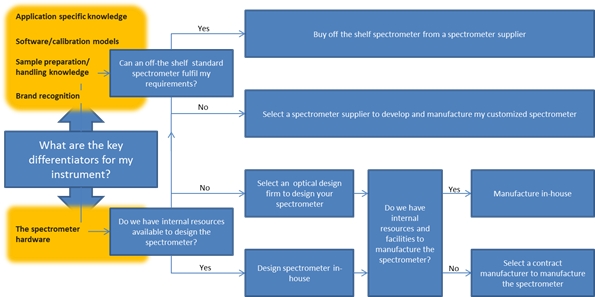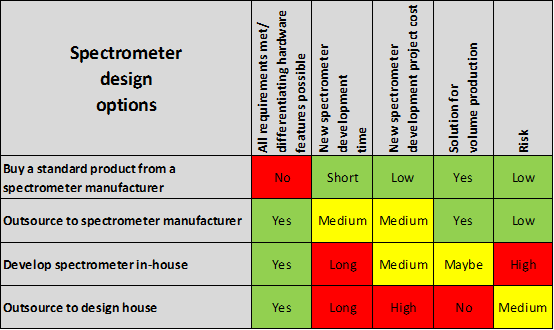Make or buy your spectrometer
Introduction
One of the challenges instrument makers face today is an increasing need to bring new innovative products to the market faster and with lower cost. Spectrometers are an essential component in analytical instruments for a broad range of applications, in for instance the life science, pharma, and process industries. Spectrometers are opto-mechanical modules that require specialized knowledge and equipment to design and manufacture. For many instrument companies it is not obvious which strategy – make or buy– they should choose for the spectrometer when starting a new instrument design.
The intent of this white paper; Make or Buy your Spectrometer, is to provide some insights that can help you decide which path works best for your application. We evaluate pros and cons of the following four common approaches:
- Buy an off-the-shelf standard product from a spectrometer supplier
- Out-source development and manufacturing to a spectrometer supplier
- Design and manufacture the spectrometer in-house
- Out-source development to an external consultancy company and manufacture yourself or at a contract manufacturer
Figure 1 outlines the key decision process in order to evaluate which of these four options is the best option for you. In the following we will discuss Figure 1 in more detail.

Figure 1: Process for spectrometer make or buy decision.
What are the key differentiators of your product?
Which solution best fits your needs depends first of all on how critical the spectrometer is for your business. The differentiating factor of your analytical instrument typically lies within your calibration models, specific application knowledge, and/or specific sample handling knowhow, rather than the specific hardware used in the instrument. The spectrometer – being one piece of the hardware – is almost a commodity as long as it covers the right wavelength range and provides good enough resolution. If this is the case there is no compelling reason to maintain internal resources to develop and manufacture spectrometers. In contrast – if the actual performance or implementation of the spectrometer is the unique and sustainable differentiating factor for your instrument – you should consider keeping this knowledge in-house under your control.
Customized or standard product?
Once you have defined your requirements you should check if an off-the-shelf spectrometer can fulfil your needs. Although this sounds simple it can be a rather iterative approach because there rarely is a clear connection between your instrument performance requirements and the spectrometer requirements. For instance, you may be able to select a spectrometer with lower performance than anticipated at first by improving performance of another part of your instrument (software model, collection optics, or light source power for example).
Not only the hard performance parameters like wavelength range, resolution, and signal-to-noise ratio matter. The spectrometer supplier’s ability to supply consistent quality spectrometers on time is crucial for your business. As an example, if the unit-to-unit variation is large among supplied spectrometers you may need to spend more time in your production calibrating each individual unit or performing more rework to hide this variability for your end customer. Many standard spectrometers have been designed with single unit, stand-alone usage in mind, with unit-to-unit variability not viewed as a major concern. Different customers simply make their own individual calibration routines and are likely not going to compare results across multiple instruments. However, as described above, variability can lead to major issues in your instrument production flow and should be avoided through a robust design of the spectrometer.
A spectrometer supplier’s responsiveness to customer support issues and flexibility to adapt to your changing supply demand are also very important to evaluate. Basically, you need to select a supplier that has a true OEM focus.
In-house or out-sourced spectrometer development?
In some cases, when considering all of the above criteria, it may be that you can actually find a standard spectrometer from a good OEM spectrometer supplier in which case that is obviously the lowest cost, less risky, and fastest route to your new spectrometer. On the other hand, there are situations where your requirements are too far from anything you can obtain with a standard spectrometer. In those cases you need to consider having a custom spectrometer designed.
The design of a spectrometer requires an engineering team with skills in optical ray tracing, mechanical CAD design, electronics and software development. Furthermore, it is crucial that the team knows how to design for volume manufacturing with low unit-to-unit variation and easy assembly of the final product. Thermal stability and robustness versus vibration and shock impacts also needs to be evaluated during the design phase.
You have essentially three options for designing a spectrometer
- Out-source to a consultant development house
- Out-source to a spectrometer manufacturing company
- Do it in-house
If you have a development team in-house with the specialized skills and available time it is an obvious option to develop the spectrometer in-house. However, even at large scientific instrument companies, the amount of new spectrometer development projects is likely only going to be 1 project every 2–5 years. So, it may be hard to justify a specialized development team and to maintain their skills over time.
If you choose to out-source development to a consultancy company with experience in opto-mechanical design you benefit from a pool of specialists. Obviously, you own the design and can choose where to produce the spectrometer. However, most design houses will not have experience with manufacturing of spectrometers and you risk that whatever was designed as prototypes has to be modified in order to be manufacturable in volume. This may delay your product launch and add cost to the overall development project.
Finally, if you choose to have a spectrometer supplier develop your customized spectrometer you benefit from a group of specialists that know exactly how to design for manufacturing. This means that the prototypes can go straight into production after verification. Thus, this model is likely the less risky and lowest cost option.
In-house or out-sourced spectrometer manufacturing?
Manufacturing of spectrometers is a specialized type of production that requires special opto-mechanical assembly and alignment work stations and workers trained in this kind of assembly. If your company is involved in such kind of assembly already it is likely that you can manufacture your new spectrometer in-house.
However, many instrument manufacturers focus on higher level mechanical and electronic assemblies and prefer to out-source specialized manufacturing to either a contract manufacturer or an OEM spectrometer supplier willing to produce custom spectrometers. In reality there are very few contract manufacturers with experience in spectrometer assembly so, in most cases you would be better off by choosing a spectrometer supplier that has vast experience in this particular type of assembly.
Summary
The table below summarizes the different benefits and drawbacks of the four different options for selecting a new spectrometer for a new instrument development. A standard spectrometer will not offer you any differentiating features but, if it fits your requirements this is the fastest and lowest cost path to a spectrometer for your new instrument design. If you do need customized features, a spectrometer supplier will likely be the fastest and lowest cost option to a manufacturable spectrometer. Designing everything in-house is likely going to take longer time and have higher risk of going wrong somewhere along the development project. And finally, out-sourcing fully or in part to an external consultancy firm is likely the most expensive solution.

Want to know more?
For further information see below.